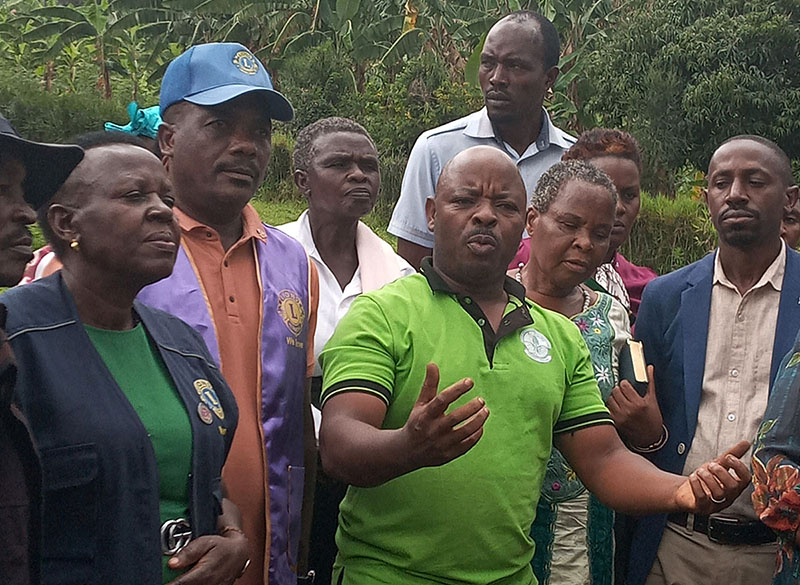Residents, stakeholders start restoration of Ibanda hills
Mabanga is prone to mudslides whenever it rains heavily. According to Bogere, the degradation of the hills through stone quarrying and poor cultivation methods has left them bare, exposing them to soil erosion and mudslides that endanger residents’ lives.
Ibanda Hills have been degraded through stone quarrying and poor cultivation methods that have left them bare, exposing them to soil erosion and mudslides. (Photo by Stephen Nuwagira)
________________
Bernard Bogere, a resident of Mabanga cell in Katooma ward, Kagongo division, Ibanda Municipality, lives at the foot of Katooma hill, part of the Ibanda range of hills.
Mabanga is prone to mudslides whenever it rains heavily. According to Bogere, the degradation of the hills through stone quarrying and poor cultivation methods has left them bare, exposing them to soil erosion and mudslides that endanger residents’ lives.
Flazzy Ntarwete, from the same village, said many houses in Kakunyu trading centre are struck by floods and rocks from uphill during heavy rains. Ntarwete, whose home was affected by mudslides last year, added that the village risks being buried by mud and rocks in the future if the hills are not protected from further degradation.
New dawn
Speaking during the launch of the Ibanda Hills Ecosystem Restoration Project, the duo called for the sensitisation of residents on sustainable land use and individual responsibilities in restoring the Ibanda hills. They urged the government to provide tree seedlings to support the restoration process, saying many people were too poor to afford them.
Spearheaded by the Ibanda-based Green Environment Organisation (GEO), the project aims to promote tree planting on the Ibanda hills as part of efforts to restore and conserve them. According to GEO team leader Simon Muhumuza, over 40,000 tree seedlings have already been distributed to villages at the foot of the hills for planting. These include ocaria, prunus africana, mango, jackfruit, mahogany, musizi and albizia seedlings, among others.
GEO team leader Simon Muhumuza speaks at the launch of the tree planting initiative at Katooma Catholic Church. Over 40,000 tree seedlings have been distributed to villages at the foot of Ibanda Hills. (Photo by Stephen Nuwagira)
Hundreds of trees were planted on Katooma hill by residents of Mabanga and GEO partners during the launch event.
Kakunyu trading centre in Katooma II, Mabanga, Buhumuriro trading centre, and Nyakatookye, Kyaruhanga, Kyeikucu and Rugazi, all located at the foot of the Ibanda hills, are among the areas most affected by mudslides during heavy rains.
In 2023, the Ibanda–Kitagwenda road was cut off by rocks and mud at Kakunyu trading centre, forcing motorists to use longer alternative routes. This road also serves Uganda Martyrs Ibanda Hospital, the main health facility for Ibanda and neighbouring districts.
Community leaders say
Former mayor of the then Ibanda town council, Deus Mulinde, called for continued community sensitisation on the importance of environmental conservation to address the situation.
He encouraged residents to embrace tree planting and agroforestry, especially for coffee and banana growers, as an alternative source of income that also supports environmental conservation.
He further noted that air quality had been affected by degradation.
Rev. Fr. Evarist Ariyo, deputy parish priest of Ibanda Parish, encouraged households to support conservation efforts by planting fruit trees to provide food and generate income for their families.
Elizabeth Asiimwe, a member of GEO and the Lions Club Ibanda, said it was important for residents to take ownership of the restoration exercise for it to succeed. She urged them to engage in alternative income-generating activities such as beekeeping, which also promotes conservation.
Challenge
According to Saul Twongyeirwe, residents have not been sensitised on the sustainable use of hilly areas. “That’s why past interventions failed. So, it is important the residents are trained on how to coexist with the kind of environment and also get alternative means of survival to sustain their families,” he said.
However, the restoration campaign by GEO and other stakeholders points in the right direction. In addition to mitigating potential disasters resulting from hill degradation, residents like Bogere will benefit from sustainable livelihoods through tree planting and the growing of fodder crops.